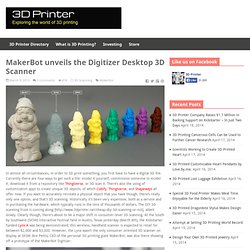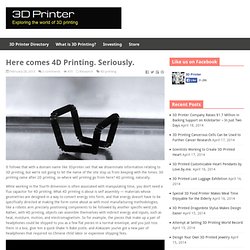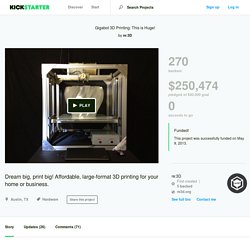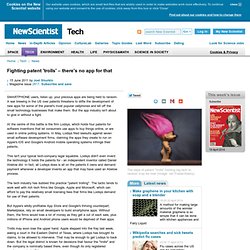

3D print a vase from your tablet. MakerBot unveils the Digitizer Desktop 3D Scanner. In almost all circumstances, in order to 3D print something, you first have to have a digital 3D file.

Currently there are four ways to get such a file: model it yourself, commission someone to model it, download it from a repository like Thingiverse, or 3D scan it. There’s also the using of customization apps to create unique 3D objects, of which Cubify, Thingiverse, and Shapeways all offer now. Here comes 4D Printing. Seriously.
It follows that with a domain name like 3Dprinter.net that we disseminate information relating to 3D printing, but we’re not going to let the name of the site stop us from keeping with the times. 3D printing came after 2D printing, so where will printing go from here?

4D printing, naturally. While working in the fourth dimension is often associated with manipulating time, you don’t need a flux capacitor for 4D printing. What 4D printing is about is self assembly — materials whose geometries are designed in a way to convert energy into form, and that energy doesn’t have to be specifically directed at making the form come about as with most manufacturing methodologies, like a robotic arm precisely positioning components to be followed by another specific weld job. Rather, with 4D printing, objects can assemble themselves with indirect energy and inputs, such as heat, moisture, motion, and electromagnetism.
This will likely be as revolutionary as 3D printing itself. Gigabot 3D Printing: This is Huge! by re:3D. Share this project Done Share Tweet Embed Tweet Share Email Gigabot 3D Printing: This is Huge!

By re:3D Play Dream big, print big! Tōhoku Japanese Earthquake Sculpture. This sculpture was made to contemplate the 2011 Tōhoku earthquake and tsunami in Japan.

To create the sculpture a seismogram of the earthquake, was rotated using computer aided design and then printed in 3 dimensions using rapid prototyping technology. The artwork measures 30cm x 20cm and represents 9 minutes of the earthquake. The sculpture will be presented at the Jerwood Space in London for a show called Terra. Exploring how data is read and can be represented and interpreted, the artwork is one of a series of data visualization sculptures Jerram has recently created. Bathsheba Sculpture. 3D-printed dress for Dita Von Teese. New York designer Michael Schmidt and architect Francis Bitonti have created a 3D-printed dress for burlesque dancer Dita Von Teese.

Images above and top by Albert Sanchez. The ATF Has Yet to Be Convinced That 3D-Printed Guns Compare to the Real Thing. An unnamed Defense Distributed supporter tests out an iteration of the group's lower receiver, which is the translucent part of the rifle above.

Around the same time that Cody Wilson took the stage at SXSW to discuss his new for-profit 3D-printing design database earlier this month, the Bureau of Alcohol, Tobacco, Firearms and Explosives (ATF) was finalizing his application to become a federally-licensed firearms manufacturer. Wilson stood in front of the crowd and talked about how everyone should have access to technology that made it easy for them to print gun parts in their garages.
He talked about Defense Distributed, the organization he and some friends set up to offer 3D-printed gun designs to the masses for free through a website called DEFCAD, and finally addressed the government's role in the manufacture of firearms. Click, Print, Gun: The Inside Story of the 3D-Printed Gun Movement. Being a 3D-printing novice, I was once somewhat skeptical of the promise behind what's being billed as a truly game-changing technology.

I saw Makerbot CEO Bre Pettis on the cover of Wired, and while the novelty of the process incited wonder in my inner 10-year-old, I didn’t think much about it after the fact. Enter Cody R. Wilson. Wilson is a 25-year-old University of Texas law student working to build semiautomatic weapons using 3D printers. Biomedical software and solutions for Engineering on Anatomy. Materialise 3D prints anatomically correct hearts. 3D printed plastic house will be assembled "in a day" Amsterdam architects plan 3D-printed canal house. News: Dutch studio DUS Architects has joined the race to build the first 3D-printed house with plans to print a full-size canal house in Amsterdam.

DUS Architects will print components for the house on-site using a purpose-built printer called the KamerMaker (above and below) and plan to start work in the next six months. "This year we want to print the entire facade and the first room bit by bit," architect Hedwig Heinsman told Dezeen. Dreambox: the 3D printing vending machine. It will be some time before we have vending machines where we can swipe our credit card, and have most anything we want 3D printed instantly, on the spot.

No doubt it’s coming, but not yet. However, first steps in that direction are being taken. Three U.C. Berkeley students have just developed what can truly be called a 3D printing vending machine. Fighting patent 'trolls' – there's no app for that - tech - 15 June 2011. SMARTPHONE users, listen up: your precious apps are being held to ransom.

A war brewing in the US over patents threatens to stifle the development of new apps for some of the planet's most popular cellphones and kill off the small technology businesses that make them. But the app industry isn't about to give in without a fight. At the centre of this battle is the firm Lodsys, which holds four patents for software inventions that let consumers use apps to buy things online, or are used in online polling systems. In May, Lodsys filed lawsuits against seven small software development firms, claiming the apps they create to run on Apple's iOS and Google's Android mobile operating systems infringe their patents. This isn't your typical tech-company legal squabble. The tech industry has dubbed this practice "patent trolling". But Apple's wildly profitable App Store and Google's thriving counterpart, Marketplace, rely on small developers to build smartphone apps. Who's Liable for Crimes Committed With 3D-Printed Guns?
With the announcement this week that a handgun made from a 3D printer fired successfully, 3D manufacturers may soon find themselves in a gray area when it comes to liability. From the looks of it, these companies aren’t ready for the new wave of customers and responsibility this might bring. According to the BBC, designs for the Liberator plastic pistol have been downloaded more than 100,000 times already — before the U.S. government ordered that the designs be taken down for fear they may violate arms-exporting laws.
Still, the designs are out there, accessible through sites such as The Pirate Bay. “Makers,” or hobbyists, with their own 3D printers, such as the MakerBot Replicator 2 ($2,199) and 3DSystems CubeX ($2,499), are presumably still free to print it and whatever else they want. [See also: 3D Printers at Maker Faire: Faster, Cheaper, Easier to Use] What Lies Ahead for 3-D Printing?